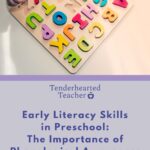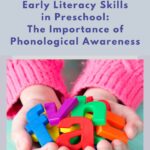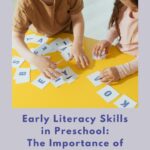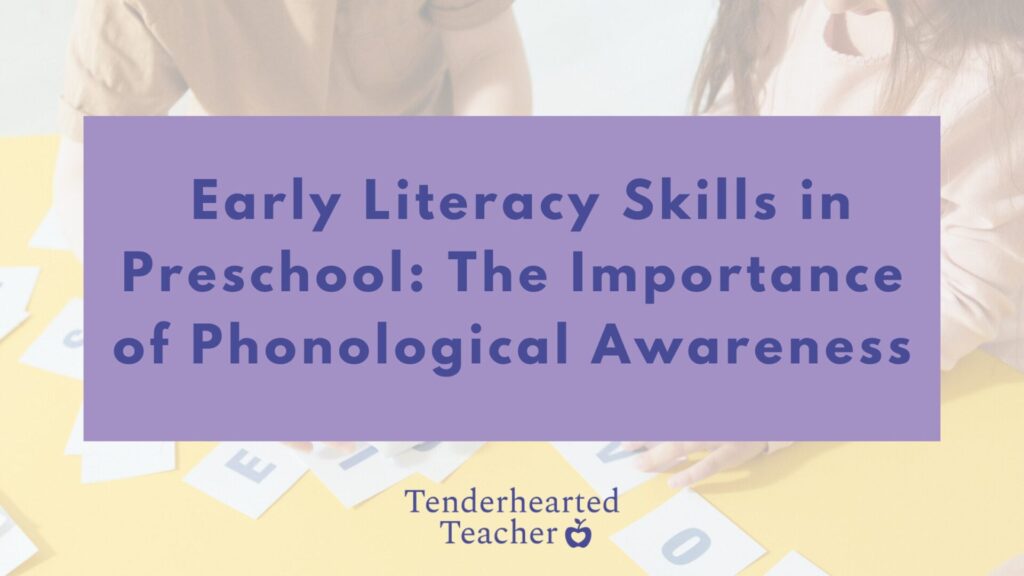
Most parents know that reading aloud to their children every day is a positive first step toward future reading success. But, there are other simple strategies that contribute to literacy learning that are just as important. In fact, several foundational or emergent skills are necessary before a young child learns to read. These include print awareness, vocabulary building, narrative skills such as storytelling and retelling, and phonological awareness. Today, we’ll dive into phonological awareness, which is one of the strongest predictors of future reading skills. Plus, I’ll share activities and resources to develop these skills at home!
Please note: This post may contain affiliate links. As an Amazon Associate, I earn from qualifying purchases. Therefore, if you buy something through these links I will receive a small commission at no extra cost to you. Thank you for your support.
The National Institute for Early Education Research states, “Language and literacy develop concurrently and influence one another. What children learn from listening and talking contributes to their ability to read and write, and vice versa.”
Therefore, it’s important to practice phonological awareness skills by having your child listen for sounds, through rhyming, alliteration, and syllabification in their daily routine. You can do this when you’re singing songs, reading books, going on walks, or playing with toys together. For example, if you’re walking through the supermarket, you can say something like, “Look at all this fruit. I see berries and bananas. Do the words BERRIES and BANANAS start with the same sound? Yes, we hear the /b/ sound. What about PEACHES and APPLES? No, those have different sounds. We hear /p/ in peaches and /a/ in apples.” Or if you’re reading a book, you can point out words that rhyme, i.e., “these two words have the same middle and ending sounds, listen: MOUSE and HOUSE.”
So What Is Phonological Awareness?
Phonological awareness is an umbrella term to explain the ability to recognize (hear) and manipulate (play with) the sounds of spoken language and the skills needed to do so. The North Carolina Department of Public Instruction explains this process clearly. They state, “Phonological awareness refers to the bigger ‘chunks’ or ‘parts’ of language. When we ask students to rhyme, blend small words to make a compound word, break words apart into syllables or onset-rime, we are working at the phonological awareness level. Phonemic awareness is a part of phonological awareness. Phonemic awareness is the ability to recognize and manipulate each sound in a word. Phonological/phonemic awareness focuses on sounds and does not include written letters or words.“
Phonological Awareness: Keywords
Here are a few helpful terms for understanding phonological awareness and the skills that fall under it. (Adapted from Heggerty’s Phonemic Awareness Kindergarten Curriculum- 2022 Edition.)
Phonological awareness
The ability to hear and recognize the sounds of spoken language and manipulate those sounds through skills such as rhyming, identifying onsets and rimes, breaking words into syllables, and phonemic awareness.
Phonemic awareness
A sub-domain and later-developing component of phonological awareness in which a person can recognize and manipulate the smallest unit of sound (phoneme).
Phonemes
The individual sounds in a given word. For example, the word CAT has three phonemes: /k/ /ă/ /t/. There are 44 phonemes in the English language, including sounds for the 26 individual letters of the alphabet as well as letter combinations.
Phonics
The understanding of letter-sound correspondence and its use in reading and spelling. Phonics focuses on the letters that represent sounds and involves printed or written language, while phonological and phonemic awareness focus on auditory and oral language skills.
Rhymes
Words that have the same middle and ending sounds, such as cat, bat, hat, and rat. Some rhyming words may be spelled differently, but still sound the same at the end when read aloud, i.e., pears and chairs.
Onset and Rimes
Onset is the part of a single-syllable word that comes before the first vowel, which is usually the beginning sound (initial consonant or blend). Rime is the vowel and the remaining letters after it. Ex. In the word MAP, the onset is /m/ and the rime is /ap./ In the word FROG, the onset is /fr/ and the rime is /og./
Syllables
Part of a word that contains a single vowel sound and is pronounced as a unit, sometimes called “beats.”
Syllabification
The act of dividing words into syllables. Ex: The word WINTER has two syllables: win-ter. The word PAJAMAS has three syllables: pa-ja-mas.
Alliteration
A series of two or more closely connected words that begin with the same initial sound. Ex. Peter Piper picked a peck of pickled peppers.
Why Is Phonological Awareness Important?
Phonological awareness is a key building block for learning to read because it helps children understand that words are made up of sounds, prepares them to decode (sound out) words when reading, and builds a foundation for spelling and writing.
Reading Rockets states, “Phonological awareness (PA) involves a continuum of skills that develop over time and that are crucial for reading and spelling success because they are central to learning to decode and spell printed words. Phonological awareness is especially important at the earliest stages of reading development — in pre-school, kindergarten, and first grade for typical readers. Explicit teaching of phonological awareness in these early years can eliminate future reading problems for many students.”
Therefore, children who develop strong phonological awareness in preschool are more likely to become successful readers later in school. Conversely, those with weaker phonological awareness skills may struggle with reading as they get older.
How to Build Phonological Awareness at Home
Before I share activities that you can do at home to enhance phonological awareness, I think it’s important to provide examples of the proper pronunciation of each letter sound. Parents and teachers, sometimes inadvertently, add an extra “uh” or “schwa” sound when teaching phonemes. This can be confusing when a child begins to sound out words independently. For example, if a child consistently hears B = buh, instead of the correct sound /b/, they may eventually read the word “big” as “buh-i-g,” instead of “b-i-g.”
These two videos are especially helpful for teaching proper pronunciation. Additionally, I’d like to share this word-mapper resource from Phonics and Stuff. Type in any word, and it will map out the phonemes. Plus, you can click on each phoneme to hear the individual sound.
Phonological Awareness Activities
Enhancing phonological awareness doesn’t have to look like formal lessons with worksheets. Instead, it can be done with playful interactions and games. Here are a few activities that practice important early literacy skills:

Songs and Chants
Daily exposure to the rhythm and repetition of songs, chants, nursery rhymes, and fingerplays helps to reinforce sound patterns. When singing, try putting extra emphasis on the rhyming words with special movements or by using a louder voice.
Here are two helpful nursery rhymes resources, including lyrics and/or videos:
- BBC: Bitesize: Nursery Rhymes and Songs: A-Z
- Leeds, Grenville and Lanark District Health Unit: Nursery Rhyme Cards
Rhyme Time
Use books, objects, or cards to identify rhyming words. When reading, pause and let your child fill in the rhyming words.
Here are a few of my favorite books for preschoolers to introduce rhyming words:
- We search for any book you like In Chinese, Russian and Spanish Service for Businesses, Individuals, Governments, Universities Any medium you choose, that is available Read, Learn, Research and Enjoy
- Hardcover Book
- Dewdney, Anna (Author)
- English (Publication Language)
- 40 Pages - 03/19/2009 (Publication Date) - Viking Books for Young Readers (Publisher)
- Hardcover Book
- Thomas, Jan (Author)
- English (Publication Language)
- 40 Pages - 01/06/2009 (Publication Date) - Beach Lane Books (Publisher)
- Hardcover Book
- Hopgood, Sally (Author)
- English (Publication Language)
- 32 Pages - 09/20/2016 (Publication Date) - Sky Pony (Publisher)
I’ve also created a free printable with my rhyming puzzle cards to help you and your child get started with phonological awareness practice! Grab your copy below.
Beginning Sound Games
Play I-Spy or “initial sound” scavenger hunts to find objects around the house with the same beginning sound. (Ex. I-Spy items that begin with the /d/ sound. Then, your child may find objects like a doll, a dinosaur, and a donut.)
Amazing Alliteration
Have your child pick an object or animal and choose a word with the same initial sound to describe it. (Ex. Cuddly Cat, Bouncing Ball, or Big Balloon.)
Musical Syllables
Break down the syllables to familiar words or names by clapping hands or tapping on musical instruments like drums or rhythm sticks. (Ex. Your name, Sophia, has three syllables. Let’s tap them out: So-phi-a.) If you ever need help figuring out the syllables in a word, try using this online syllable counter.
- Hickory is the most popular wood choice for drumsticks due to it's classic feel and responsiveness
- All LA Special drumsticks are proudly designed, engineered, and manufactured in the USA
- Colour: Black
- All LA Special drumsticks are proudly designed, engineered, and manufactured in the USA
Some Final Points
Please remember that even though phonological awareness sounds like an intimidating concept, it can be developed through small, meaningful interactions each day. Here are a few tips to remember when practicing these skills:
- Make sure to speak clearly and slowly so your child can hear each sound.
- Keep things fun and playful. Don’t expect perfection and celebrate your child’s effort!
- Repetition is key, so try incorporating some of these games into your daily routine.
Now talk to me! What are some of your favorite phonological awareness activities to do at home with your little one? Comment below.
SAVE TO PINTEREST
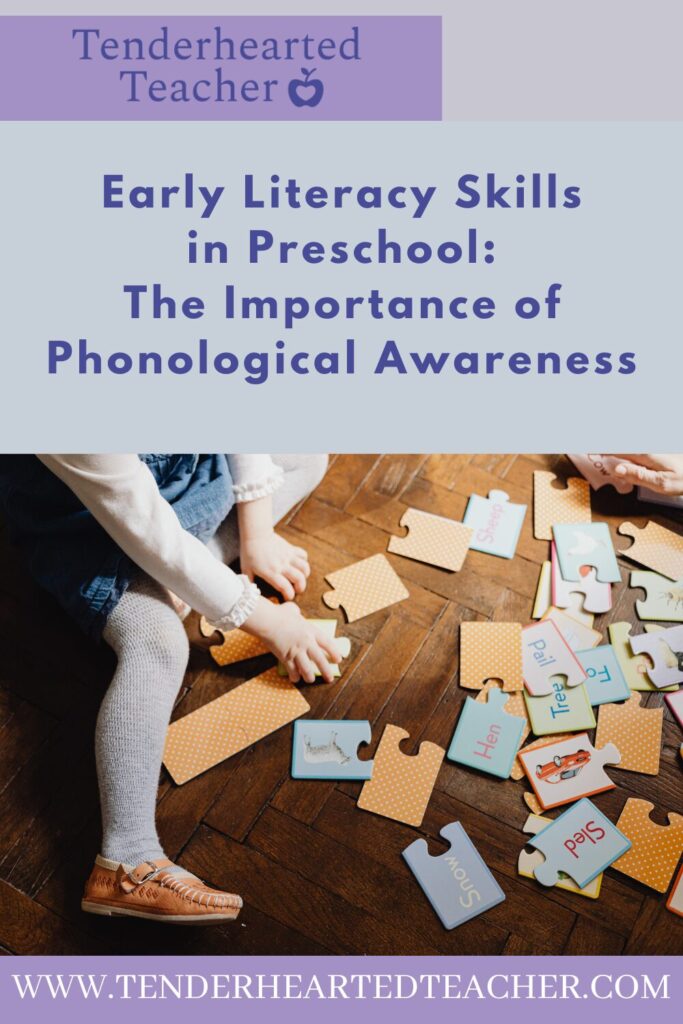
References:
Heggerty, M. (2022). Phonemic Awareness: Kindergarten Curriculum (2022 Ed). Literacy Resources, LLC.
https://shop.heggerty.org/product/kindergarten-phonemic-awareness-curriculum-english-2022-edition/
Strickland, D. S., & Riley-Ayers, S. (2006). Early Literacy: Policy and Practice in the Preschool Years. Policy Research Brief: National Institute for Early Education Research, (10).




